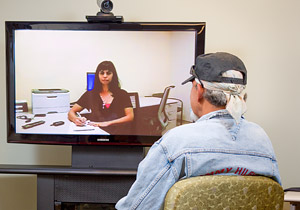
Useful Links
|
Using Technology to Improve Access to Mental Health Care 
“The major premise of VA’s suicide prevention program is that ready access to high quality mental health care will make a difference.” — Jan Kemp, National Mental Health Program Director, Department of Veterans Affairs In an effort to improve Veterans’ access to mental health care and perhaps lower the suicide rate among the Veteran population, the Department of Veterans Affairs hopes to provide 200,000 video conferencing consultations — also known as telemental health — before the end of the year. VA has also decided it will no longer charge Veterans a co-payment for any Telehealth services it provides. “We provided 140,000 remote mental health visits to 55,000 Veterans through our community-based outpatient clinics in fiscal year 2011,” said Linda Godleski, director of VA’s National Telemental Health Center and a psychiatrist at Yale University. “That’s more than double the rate of telemental health services delivered in 2008.” Godleski said VA’s videoconferencing program, which began in the early 2000s as a way to manage medication, has grown to encompass a wide range of mental health services, including suicide prevention evaluations. “When clinically appropriate,” Godleski said, “remote visits can provide immediate evaluation of suicidal patients without requiring transport to a remote facility. In some cases, we can even prevent hospitalization.” Godleski said she and her colleagues made an interesting discovery after studying the records of 98,609 VA patients who were new to telemental health services. “We found that there was a 24 percent decrease in hospitalizations, in an average of six months, after receiving remote care when compared to the same period before receiving remote care,” she observed. “We found that the number of days these patients were hospitalized decreased by close to 27 percent.” Patricia Ryan, Associate Chief Consultant for the VA Office of Telehealth, said she believes VA’s increased use of Telehealth services could play a significant role in providing mental health services to Veterans — a vital component of suicide prevention. “Telemental health gives Veterans much greater access to the services they need should they find themselves in crisis.” — Patricia Ryan, Associate Chief Consultant, “The technology allows patients to connect with their specialists easier,” she said. “Often times, Veterans are disabled or living in rural communities. This can make it difficult or costly for them to travel to see a VA specialist. With telemental health, they don’t have to drive to a VA clinic or medical center to get the help they need. They don’t even need to leave their home.” She added: “Telemental health gives Veterans much greater access to the services they need should they find themselves in crisis. We can monitor them more closely, and provide them with the help they need, when they need it.” Jan Kemp, who heads up VA’s Crisis Line for Veterans in Canandaigua, N.Y., said telemental health has another major advantage for many Veterans. “The fact that they can stay in their home and connect to us might help reduce the ‘shame factor’ that prevents so many Veterans and active duty personnel from seeking the help they need,” she explained. “Sometimes, in the military culture, it’s considered a sign of weakness to ask for help. And if you’re active duty, you might actually fear that reaching out for help could damage your career. Telemental health allows you to reach out for help in the privacy of your own home.” The Veteran’s Crisis Line, launched in 2007, has handled more than 600,000 calls from suicidal Veterans, active-duty troops, or their family members. Crisis Line counselors are credited with saving over 22,000 lives. Kemp said that in addition to telemental health and the Veterans Crisis Line, VA is reaching out to Veterans in other creative ways. “The fact is, Veterans increasingly are communicating with VA staff through online chats and text messages,” Kemp said. “We’re encouraging that. This kind of instant access makes it easier for them to communicate with VA staff and seek immediate help wherever they are, which may lessen their chances of developing suicidal thoughts.” |
